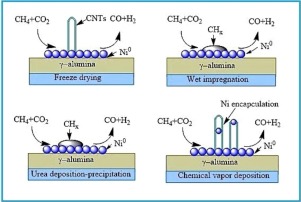Applied Catalysis A: General ( IF 5.5 ) Pub Date : 2018-02-24 , DOI: 10.1016/j.apcata.2018.01.007 Mumtaj Shah , Subhasis Das , Ameeya Kumar Nayak , Prasenjit Mondal , Ankur Bordoloi

|
A strategy has been made to design a more active and stable metal-support interface by controlled synthesis of Ni nanoparticle on bimodal alumina support for CO2 reforming with methane. A bimodal porous alumina support was prepared via the evaporation-induced self-assembly (EISA) method, and the nickel nanoparticles (5 wt.%) on bimodal alumina was synthesized using four different synthesis methods such as freeze drying, wet impregnation, urea deposition-precipitation, and chemical vapor deposition method. The reactivity of nickel nanoparticles was evaluated for CO2 reforming with methane, concerning the CO2 and CH4 conversion as well as the H2 to CO ratio of the produced syngas. The catalysts were thoroughly characterized before and after the reaction using different techniques such as X-ray diffraction (XRD), N2 sorption analysis, H2-temperature programmed reduction (H2-TPR), H2-temperature programmed desorption (H2-TPD), thermogravimetric analysis (TGA), scanning electron microscopy (SEM), inductive coupled plasma-mass spectrometry (ICP-MS) and transmission electron microscopy (TEM). Characterization of various catalysts revealed that variation of synthesis procedure affects the metal-support interface and the type of nickel species present on the γ-alumina support, as well as the textural properties of the catalysts. The catalytic behavior was entirely different for each of the as-developed metal-support interface, derived in by the use of different synthesis procedures. The catalyst prepared by urea deposition-precipitation method was found to be most active and stable at 700 °C and 1atm for a period of a 100h run of time on stream with diluted gas feed and even without the dilution of feed gas for next 25h of the run. Comparing with bimodal catalyst, a unimodal catalyst with same metal loading exhibited the inferior catalytic activity and stability. The results of the comparative study showed that the stable catalytic performance of the bimodal structured catalyst is due to the combined effect of the type of metal-support interface of the catalyst, smaller size of nickel particle and bimodal structure of support material. The bimodal pore character of catalyst support has shown to prevent, Ni particles from sintering during the reaction and hence, better catalytic performance and resistance to coking.
中文翻译:

难干重整催化剂的金属-载体界面的智能设计
通过在双峰氧化铝载体上进行受控的Ni纳米粒子的合成,设计出一种活性更高,更稳定的金属-载体界面的策略,用于用甲烷重整CO 2。通过蒸发诱导自组装(EISA)方法制备双峰多孔氧化铝载体,并使用四种不同的合成方法(如冷冻干燥,湿法浸渍,尿素沉积)合成双峰氧化铝上的镍纳米颗粒(5 wt。%)。 -沉淀和化学气相沉积方法。评估了镍纳米颗粒对甲烷进行CO 2重整的反应性,涉及到CO 2和CH 4的转化率以及H 2的转化率产生的合成气对CO的比率。该催化剂前和使用不同的技术,例如X射线衍射(XRD),N在反应后进行充分表征2吸附分析,H 2 -温度编程还原(H 2,H -TPR)2 -温度编程解吸(H 2-TPD),热重分析(TGA),扫描电子显微镜(SEM),电感耦合等离子体质谱(ICP-MS)和透射电子显微镜(TEM)。各种催化剂的表征表明,合成方法的变化会影响金属-载体界面和γ-氧化铝载体上存在的镍物种的类型,以及催化剂的质构性质。对于每个已开发的金属-载体界面,其催化行为是完全不同的,这是通过使用不同的合成程序得出的。发现通过尿素沉积-沉淀法制备的催化剂在700°C和1atm的温度下在100h的运行时间内具有稀释的气体进料,即使在没有稀释的进料气的情况下,其活性也是最稳定的,持续时间为100h。运行。与双峰催化剂相比,具有相同金属负载量的单峰催化剂表现出较差的催化活性和稳定性。比较研究结果表明,双峰结构催化剂的稳定催化性能是由于催化剂的金属-载体界面类型,较小的镍颗粒尺寸和载体材料的双峰结构共同作用的结果。催化剂载体的双峰孔隙特性已显示出可防止Ni颗粒在反应过程中烧结,因此可提高催化性能和抗结焦性。比较研究结果表明,双峰结构催化剂的稳定催化性能是由于催化剂的金属-载体界面类型,较小的镍颗粒尺寸和载体材料的双峰结构共同作用的结果。催化剂载体的双峰孔隙特性已显示出可防止Ni颗粒在反应过程中烧结,因此可提高催化性能和抗结焦性。比较研究结果表明,双峰结构催化剂的稳定催化性能是由于催化剂的金属-载体界面类型,较小的镍颗粒尺寸和载体材料的双峰结构共同作用的结果。催化剂载体的双峰孔隙特性已显示出可防止Ni颗粒在反应过程中烧结,因此可提高催化性能和抗结焦性。



























 京公网安备 11010802027423号
京公网安备 11010802027423号